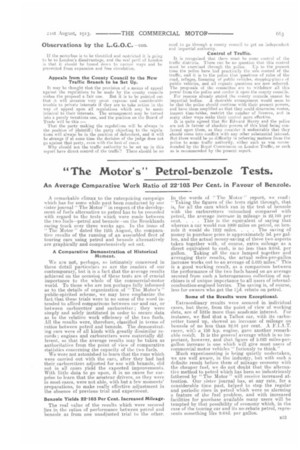"The Motor's" Petrol-benzole Tests.
Page 7

If you've noticed an error in this article please click here to report it so we can fix it.
An Average Comparative Work Ratio of 22105 Per Cent. in Favour of Benzoic.
A remarkable climax to the enterprising campaign which has for some while past been conducted by our mister journal " The Motor "in respect, of the development of fuels alternative to petrol has to be recorded with regard to the tests which were made between the two fuels—petrol and benzole—on the Brookla,nds racing track Over three weeks ago. In the issue of " The Motor " dated the nth August, the comparative results of the running of an assemblod fleet of touring cars using petrol and benzole alternatively are graphically and comprehensively set out
A Comparative Demonstration of Historical Moment.
We are not, perhaps, sointimately concerned in these detail particulars as are the readers of our contemporary, but it is a fact that the average results achieved on the occasion of these tests are of crucial importance to the whole of the commercial-motor world. To those who are not perhaps fully informed as to the details of organization of " The Motor's " public-spirited scheme, we may here emphasize the fact that these trials were in no sense of the word intended to afford comparisons between car and ear, or between carburettor and carburetter; they were simply and solely instituted in order to secure data as to the relative work efficiency of the two fuels. All the results were, therefore, classified in terms of ratios between petrol and benzole. The demonstrating cars were oi all kinds with greatly dissimilar records ; engines and carburetters were materially different, so that the average results may be taken as authoritative from the point of view of comparative statistics concerning the capacity of the two fuels.
We were not astonished to learn that the runs which were carried out with the cars, after they had had their carburetters adjusted for use with benzole, did not in all cases yield the expected improvements. With little data to go upon, it is no cause for surprise to learn that the amateur drivers, as they were in most cases, were not able, with but a few moments' preparations, to make really effective adjustment in the absence of previous trial and experiment.
Benzole Yields 22.105 Per Cent. Increased Mileage.
The real value of the results which were secured lies in the ratios of performance between petrol and benzoic as from one unadjusted trial to the other. In the words of " The Motor " report, we read ; "Taking the figures of the tests right through, that is, for all the cars which ran in the test of benzoic with the carburetters ntouched compared with petrol, the average increase in mileage is 22.103 per cent. . . This is the equivalent of saying that whereas a car would run 1000 miles on petrol, on benzole it would do 1222 miles. . . . The saving of money in purchase price is approximately 5d. per gallon, and the actual money-saving of these two aspects taken together with, of course, extra mileage as a direct equivalent to cash, is no less than 9.04d. per
gallon. Taking all the cars lumped together and averaging their results, the actual miles-per-gallon increase works out to an average of 5.023 miles," This is a good working result, as a comparison between the performance of the two fuels based on an average secured from such a heterogeneous collection of machines is of unique importance to all users of internalcombustion-engmed lorries. The saving is, of course, less for owners who get the 11d. rebate on petrol.
Some of the Results were Exceptional.
• Extraordinary results were secured in individual eases, but these, from the point of view of working data, are of little more than academic interest, For instance, we find that a Talbot car, with its carburetter tuned up, showed an increase of mileage on benzole of no less than 52.91 per cent. A F.I.A.T. racer, with a 150 h.p. engine, gave another remarkable reside It is the general average which is so im portant, however, arii d that figure of 5.023 miles-pergallon increase is one which will give most users of commercial-motor vehicles furiously to think."
Much experimenting is being quietly undertaken, we are well aware, in the industry, but with sueln definite result before them of mileage economy with the cheaper fuel, we do not doubt that the alternative method to petrol which has been so industriously fathered by " The Motor " will receive increased attention. Our sister journal has, at any rate, for a considerable time, past, helped to stop the regular and periodic rises in petrol which were so alarming a feature of the fuel problem, and with increased facilities for purchase available many users will be tempted by that possibility of economy which, in the case of the touring car and its no-rebate petrol, represents something like 9.64d. per gallon.




















